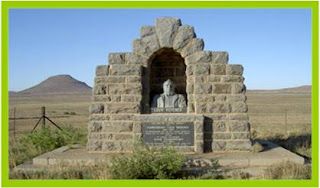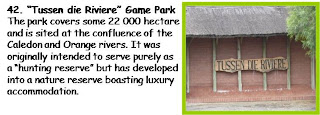Gariep Dam. Gariep is derived from the San meaning "red water". The decision to site the dam wall near Novals Pont was a disappointment for Bethulie as it was hoped that it would be close to Bethulie. A delegation met the Minister to discuss the impact of this decision as it meant that the Bethulie district would lose some 60% of its land area and it would necessitate the construction of a new road and rail link. The dam measures 360 km2 and has a shoreline of 435km. The Oviston project feeds water via a tunnel some 80km long to the Fish River. Construction was completed in 1972 and the official opening took place on March 04 1972. The name change from Hendrik Verwoerd Dam to Gariep Dam took effect on 01 April 1995.
Louw Wepener Monument. Kommandant Wepener will be remembered for his bravery in battle. The South African Defence Force honoured him by way of the "Louw Wepener Award" for bravery for its members. Wepener fought in the 6th and 7th eastern border wars and in defiance of the British, supported the Freestaters in their skirmishes with the Basothos. He would have settled in the Free State had it not been under British control. Instead he settled in De Nek between Aliwal North and Jamestown. A monument in his honour was erected here. In 1862 he bought the farm "Constantia" situated near Bethulie where he was later buried.
Venter Farm: JJ (Koos) Venter, 3 times acting President of the Orange Free State and Member of Parliament during the 80's settled on the farm "Broekpoort". His remains lie buried at Elim, a portion of Broekpoort. Remnants of his residence are still seen today on the farm. He was involved in the establishment of the first Reformed Church in the Orange Free State at Reddersburg and was also one of the founders of the Bethulie Reformed Church.
Memorial Cemetry. The construction of the Gariep Dam necessitated the relocation of the concentration camp cemetry as it was calculated that when the dam was at its highest, the cemetry would be under water. The remains of the 1714 dead were reburied in a mass grave after each ones remains had been separately stored in uniform white caskets. The headstones of each grave were placed on a wall of rememberance. The mother and child statues together with the plaques from the obelisk were also relocated. The memorial was inaugurated by the Hon CJ Swart in 1966.
Water reservoir on which two white mules are painted was built during the Anglo Boer War by the English Wiltshire Regiment to water their horses. The area also served as a depot for the supply of horses.
Hand water pump located in front of the public library is an example of pumps which were used by households. It was donated by Mr Pieter Coetzee in 1976 to symbolise the dominating role which water played in the history of Bethulie.
Concentration camp. Betwenn 4800-5000 people were interned at the largest site. During the thirteen month existence of this camp, a total od 1714 people (women and children) perished. Numerous monuments are located around Bethulie in memory of those who died here.
Migrant farmer stock camps occupied the environs during the period 1809-1832 as evidenced by Colonel Collins during a visit to the district in 1809
Remnants of a Rice fort site can still be seen today at it's position on a hill, northwest of the town. This dates back to the Anglo Boer War siege of Bethulie. Two other forts were also positioned around the town.
Local Dam. The first cement wall, some 5 metres high, was erected in the ravine in 1892, but was unsuccessful. It was rebuilt to completion in 1921.
Train bridge. The building of the Gariep Dam necessitaed the destruction of the old bridge crossing the Orange River and diverting the railroad to cross via the Hennie Steyn bridge. A new station east of Bethulie was built together with this bridge spanning the poort alongside the loacal dam. This train bridge was completed in 1970.
Batlhapin and the burial ground
Roman Catholic Church Residence. The house was purchased from a Mr Gunn in 1937. A chapel was built inside the house. After World War 2, German priests were sent here from the internment camps to be placed under house arrest.
Mynhardt Residence, where Patrick Mynhardt. actor and author of "Boy from Bethulie" grew up. He lived here until the age of 14.
Some of Patrick Mynhardt's personal belongings as well as certain stage memorabilia found a final resting place in Bethulie's Dorpshuis Twee.
2 Pellissier Street was the site of Dr Mynhardt's nursing home.
Pellissier House was built for Reverend Jean Pierre Pellissier, a missionary working in Bethulie during the period 1833-1867. It was erected by a French missionary, C Gosselin who previously lived in Basutoland (Lesotho). The woodwork was fashioned from willow originating from the banks of the Orange River, whilst the pitched roof was covered with reeds. The original house had 7 rooms with the front door facing East. The flat roofed area was added on in stages between 1852-1856. The private cemetry holds the remains of the Reverend Pellissier, his wife, his father, 4 of his children and some grandchildren. Today this building is home to the Pellissier Museum.
The Ox Wagon Monument was erected to coincide with the symbolic ox wagon trek of 1938. The Louis Trichardt wagon arrived in Bethulie on October 13th 1938. A cairn was built to commemorate the event and forms the base of the monument. The statue encompassing a wagon and the oxen was made from smelted spent cartidge cases by HJJ Myburgh who unveilled the statue in 1940. Sadly the oxen were stolen in 2005 whilst the wagon remains in the care of the local museum.
Oudefontein Voortrekker Monument. Festivals celebrating the Day of the Vow were held at Oudefontein during the period 1916-1965. In 1938 to commemorate the symbolic ox wagon trek a cairn was built. The wheel on site was made by HJJ Myburgh who also made the ox wagon replica. The monument was transferred to Bethulie in 1971.
Tswana Chief Lephoi was the leader of a group of BaTlaping refugees who settled at Bethulie in 1832. A plaque is situated on the site where Lephoi's great hut stood in 1833.
The old Power Station was built in 1937 and supplied Bethulie with electricity until 1964 when electrical power was thereafter supplied from Bloemfontein.
The Police Station's original section was built in 1907.
The Masonic Lodge, known as the Alan B Gordon Lodge is one of the oldest surviving lodges in the Free State. It was established in 1911 and the building was erected in 1920.
Site of the orphanage. Many children were orphaned after the war which prompted the Dutch Reformed Church to build an orphanage on the church grounds. Some of the blue gum trees seen today in this vicinity were planted by orphans. The orphans were later relocated to an orphanage at Ladybrand.
Dutch Reformed Church, 1887. The church was inaugurated in 1887 and declared a national monument in 1987. The original steeple was built from brick but as a consequence of construction failure was replaced in 1906 with a lesser steeple constructed with zinc. The zinc was replaced with sheet iron in 1985.
1st Dutch Reformed Church, 1864. The building is currently serving as the church hall and was inaugurated as the church in 1864. This is the 2nd oldest building in Bethulie and has been declared a national monument. During the Anglo Boer War the building was used to house British troops. In later years the building also served as a school and as the town hall.
Cenotaph was erected in memory of those from Bethulie and surrounding district who gave their lives for their country durinf WW1 and WW2. The unveiling took place on 14 March 1945. The MOTHS has until recently held a Remembrance Day Ceremony at 11 o'clock on the 11th day of the 11th month to remember not only those who fell in the world wars but also to honour those who perished during the wars in Korea, Vietnam and on our own borders.
Protea Store. Trading from these premises dates back to 1903 when the brothers de Bruyn traded as general dealers.
St Peters Church was inaugurated in 1928. It was north facing. A new building facing west was erected in 1940 on the same site. A brass cross, dating 1602 emanating from St Mark's church in Florence, Italy was donated to Ds Glover and is housed here.
The Post Office has been housed in Joubert Street since it's origin in 1828. The Post Office, as in days gone by, is the heart throb of the town. The building is a typical example of the architecture of it's time. Changes have occurred over the years but it still boasts one of the most amazing gables.
The Methodist Church was built in 1877 by Mr P Waugh. The initial building costs were estimated at 1,973 pounds. The corner stone was laid on 23rd March 1877 and the first service was held on the 13th July 1878 by Rev S D Venter. The church was also used as a school for the children from the concentration camp during the Anglo-Boer war. Today it is a private residence.
Hearse garage situated at 40 Collin Street was built in 1907 when the town acquired its first hearse. Prior to that caskets were physically carried up the hill to the cemetery.
Anglican Manse was built in 1916 and currently forms part of "Huis Uitkoms", the old age home in Bethulie.
Dutch Reformed Church in Africa was inaugurated on the 27th April 1930. The address was delivered by Reverent G Pellissier, a grandchild of the missionary. The pulpit and other material from the original mission church were used in this building.
The Reformed Church was designed by architect Gerhard Moerdijk. It was inaugurated in 1982. The original building included a tower which was subsequently demolished in 1985 due to construction failure.
The old Railway Station. The railroad linking East London to Bethulie was constructed in 1892. As a result, the passenger terminal and several of the other buildings were commissioned later in 1894. It was here that women and children held captive during the Anglo-Boer war were made to disembark and to journey on foot to the concentration camp some 2 miles away. The first child to perish in Bethulie as a consequence of the concentration camp policy died in the corrugated iron building at this station. The old station was closed in 1970 with the rerouting of the railroad and the construction of a new station built east of Bethulie.
Van Riebeeck Memorial plaque commemorates the tercentennial anniversary of Jan Van Riebeeck's landing at the Cape of Good Hope.
The horse monument is a tribute to the role the horse played in South Africa's history. The horse faces south, from where western civilisation arrived. Sculptured by Laura Rautenbach, this statue was unveiled on the 23rd April 1982. The stone forming the base of the statue was mined in the vicinity of the Hennie Steyn Bridge
Pellissier Primary School was opened in 1904 by Sir Hamilton Goold-Adams. The first headmaster, a Mr J Baikie, hailed from Scotland.









































I like it.Well done.
ReplyDeleteWe like it.Well done.
ReplyDelete